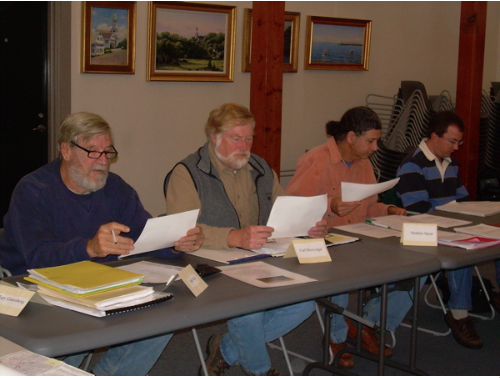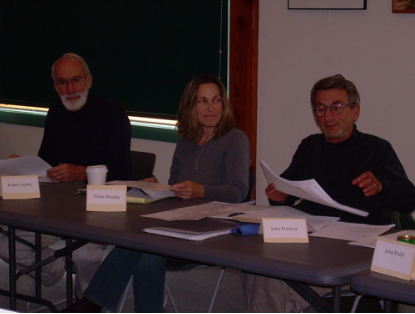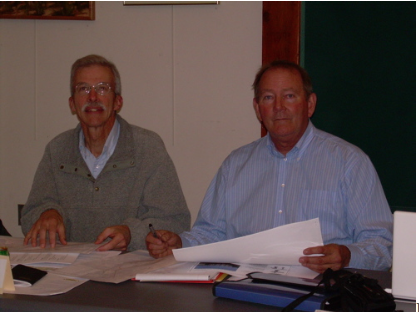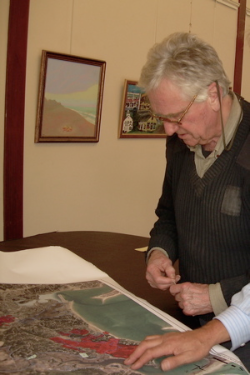The Selectmen discussed the Committee's recommendation and voted unanimous approval. According to the MOU, the Herring River Technical Committee (HRTC) was now responsible for developing a Restoration Plan. The Committee began meeting again in February. One of the first orders of business was to establish eleven and eventually 14 sub committees, cataloging issues relevant to the Restoration.






SUB COMMITTEE REPORTS
As of December. 2006, 13 of the HRTC's 14 sub committee's have reported back to the full Committee and 12 final reports have been accepted. These sub com reports contain information that will contribute to the restoration plan.
1. Vegetation Management Issues (approved August, 2006). Study of vegetation volumes, types and locations within the flood plain. Woody stemmed, intrusive upland vegetation will need a careful management plan, for removal prior to being killed by salt water. If the restoration were done in an incremental manner, vegetation could be removed sequentially. Approximately 600 acres of vegetation may require management effort. Various methods and techniques were presented. Options for disposal included: cut and sold as biomass for fuel; cut and burned on site; allowed to naturally transition (in the case of some reedy vegetation). Members: Joel Fox; Stephen Spear; Carl Breivogel; Gordon Peabody. 2. Stakeholder Issues (presented August, 2006). Just over sixty questions were gathered from residents, abutters and the Stakeholders Committee. Questions of a technical nature were answered prior to the early January, 2006 Wellfleet Selectmen's meeting. Questions regarding restoration management were answered as the HRTC began studying planning issues. Members: Robert Hubby; John Riehl. 3. Education Issues (approved August, 2006). The restoration provides a unique opportunity to share "real time" educational material. Teaching and learning concepts, from digital to on site and techniques from newsletters to a "restoration trail" were presented. Members: Robert Hubby; John Portnoy; Gordon Peabody.
4. Migration Issues (approved September, 2006). Multi species, anadromous and catadromous migrations were researched. Critical migration time windows were determined. Members: Andy Koch; Diane Murphy; Carl Breivogel.
5. Budget and Grants (approved October, 2006). Outlines potential budget issues, funding sources and grant timelines. Members: Tim Smith; John Portnoy; Stephen Spear; John Riehl. 6. Permitting Issues (approved October, 2006). Catalogues sequence of overall, multi-tiered permitting matrix, between federal, state and local agencies. Members: Hillary Greenberg; Tim Smith; John Portnoy. 7. Monitoring Issues (approved September, 2006). Provides catalogue of potential bio-indicators, parameters, protocols and sites for monitoring. Members: Diane Murphy, Andy Koch; Carl Breivogel; Gordon Peabody. 8. Restoration Histories, Lessons to be Learned (approved October, 2006). A study of New England's previous salt marsh restorations. Focus was on the nearby Hatches Harbor Restoration which provides a model for elements of our restoration plan. Common restoration problems were described. members: Tim Smith; Stephen Spear; Gordon Peabody.
9. Liaison (approved September, 2006). A catalogue of restoration partners with common interests (ecological, social, educational, administrative, financial and physical) in the restoration process. Members: John Riehl; Gordon Peabody.
10. Archives (approved October, 2006). Catalogue defining documents, electronic and hard copy, to be included in Public Record. Includes protocol for "Management and Disposition of Electronic Mail". Members: Robert Hubby; Gordon Peabody.
11. Outreach (approved October, 2006). Outlines protocol for volunteer program to be conducted through Association for the Preservation of Cape Cod (APCC), to conduct salinity monitoring. Members: John Riehl; John Portnoy. 12. Access (approved October, 2006). Catalogue of issues related to restoration area use, including shell fishing, fishing, boating, hiking and necessary support for such activities. Members: John Riehl; Gordon Peabody.
13. Restoration Impacts (interim report presented October, 2006). On going investigation of property, abutters, structures and road ways, which could be potentially impacted by restoration. Members: Jack Whelan; John Portnoy; Joel Fox; Gordon Peabody. 14. Administration (in process). Developing definitions of membership and responsibility for the future "Over Sight" Committee, which will implement restoration. Members: John Riehl; Robert Hubby; Hillary Greenberg; John Portnoy; Gordon Peabody.
Want More Information?
1. Numerous additional documents are available upon request. Please contact Gordon Peabody at 508-237-3724 or click here gordonsafeharbor@yahoo.com
2. For access to most recent documents, such as agendas, draft plans, minutes and chairman's notes, go to the CURRENT DOCUMENTS page, at the very top of this page.
3. Restoration Brochure, background and general information. Just click on the link below to read the brochure.

